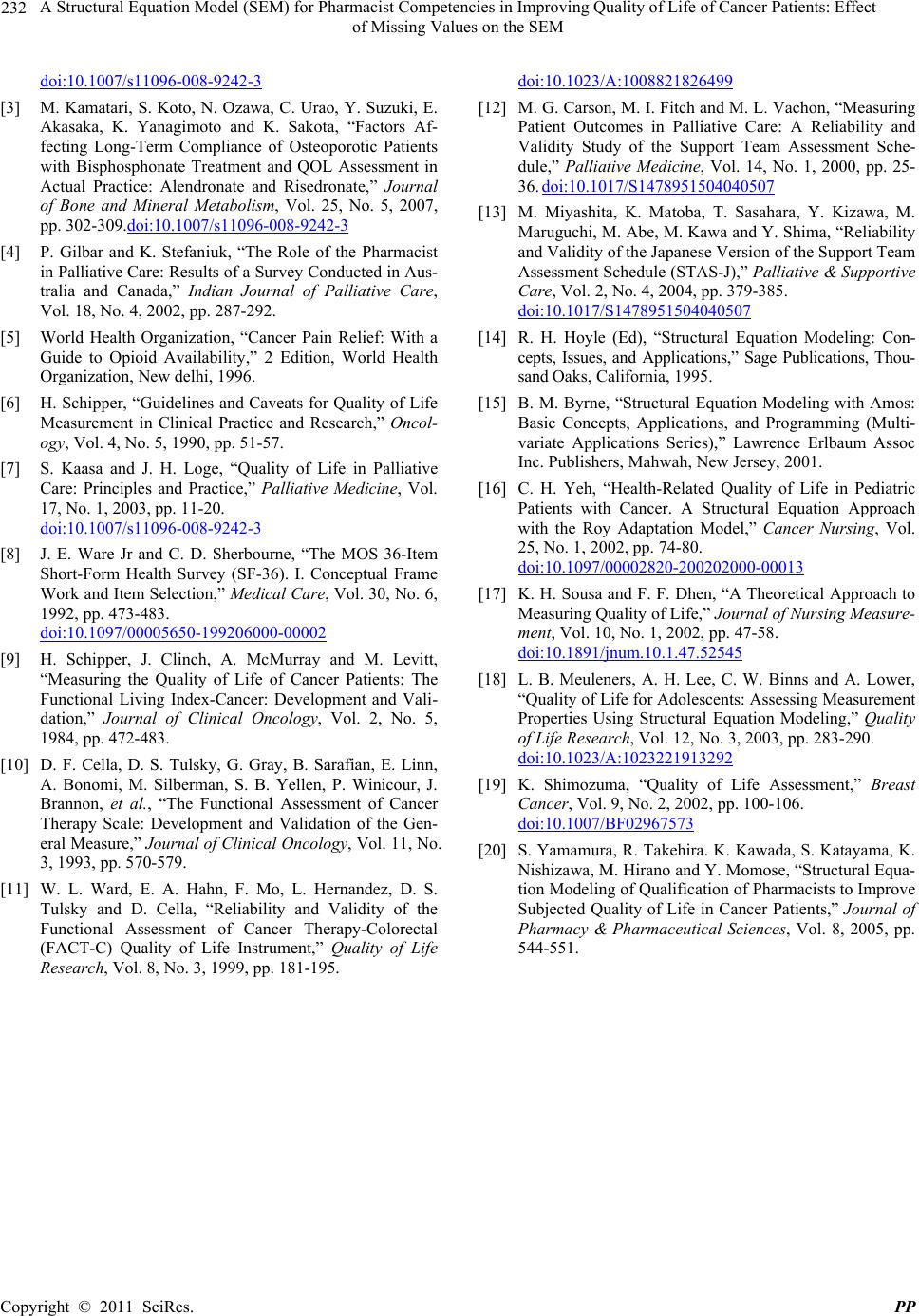
A Structural Equation Model (SEM) for Pharmacist Competencies in Improving Quality of Life of Cancer Patients: Effect
of Missing Values on the SEM
232
doi:10.1007/s11096-008-9242-3
[3] M. Kamatari, S. Koto, N. Ozawa, C. Urao, Y. Suzuki, E.
Akasaka, K. Yanagimoto and K. Sakota, “Factors Af-
fecting Long-Term Compliance of Osteoporotic Patients
with Bisphosphonate Treatment and QOL Assessment in
Actual Practice: Alendronate and Risedronate,” Journal
of Bone and Mineral Metabolism, Vol. 25, No. 5, 2007,
pp. 302-309.doi:10.1007/s11096-008-9242-3
[4] P. Gilbar and K. Stefaniuk, “The Role of the Pharmacist
in Palliative Care: Results of a Survey Conducted in Aus-
tralia and Canada,” Indian Journal of Palliative Care,
Vol. 18, No. 4, 2002, pp. 287-292.
[5] World Health Organization, “Cancer Pain Relief: With a
Guide to Opioid Availability,” 2 Edition, World Health
Organization, New delhi, 1996.
[6] H. Schipper, “Guidelines and Caveats for Quality of Life
Measurement in Clinical Practice and Research,” Oncol-
ogy, Vol. 4, No. 5, 1990, pp. 51-57.
[7] S. Kaasa and J. H. Loge, “Quality of Life in Palliative
Care: Principles and Practice,” Palliative Medicine, Vol.
17, No. 1, 2003, pp. 11-20.
doi:10.1007/s11096-008-9242-3
[8] J. E. Ware Jr and C. D. Sherbourne, “The MOS 36-Item
Short-Form Health Survey (SF-36). I. Conceptual Frame
Work and Item Selection,” Medical Care, Vol. 30, No. 6,
1992, pp. 473-483.
doi:10.1097/00005650-199206000-00002
[9] H. Schipper, J. Clinch, A. McMurray and M. Levitt,
“Measuring the Quality of Life of Cancer Patients: The
Functional Living Index-Cancer: Development and Vali-
dation,” Journal of Clinical Oncology, Vol. 2, No. 5,
1984, pp. 472-483.
[10] D. F. Cella, D. S. Tulsky, G. Gray, B. Sarafian, E. Linn,
A. Bonomi, M. Silberman, S. B. Yellen, P. Winicour, J.
Brannon, et al., “The Functional Assessment of Cancer
Therapy Scale: Development and Validation of the Gen-
eral Measure,” Journal of Clinical Oncology, Vol. 11, No.
3, 1993, pp. 570-579.
[11] W. L. Ward, E. A. Hahn, F. Mo, L. Hernandez, D. S.
Tulsky and D. Cella, “Reliability and Validity of the
Functional Assessment of Cancer Therapy-Colorectal
(FACT-C) Quality of Life Instrument,” Quality of Life
Research, Vol. 8, No. 3, 1999, pp. 181-195.
doi:10.1023/A:1008821826499
[12] M. G. Carson, M. I. Fitch and M. L. Vachon, “Measuring
Patient Outcomes in Palliative Care: A Reliability and
Validity Study of the Support Team Assessment Sche-
dule,” Palliative Medicine, Vol. 14, No. 1, 2000, pp. 25-
36. doi:10.1017/S1478951504040507
[13] M. Miyashita, K. Matoba, T. Sasahara, Y. Kizawa, M.
Maruguchi, M. Abe, M. Kawa and Y. Shima, “Reliability
and Validity of the Japanese Version of the Support Team
Assessment Schedule (STAS-J),” Palliative & Supportive
Care, Vol. 2, No. 4, 2004, pp. 379-385.
doi:10.1017/S1478951504040507
[14] R. H. Hoyle (Ed), “Structural Equation Modeling: Con-
cepts, Issues, and Applications,” Sage Publications, Thou-
sand Oaks, California, 1995.
[15] B. M. Byrne, “Structural Equation Modeling with Amos:
Basic Concepts, Applications, and Programming (Multi-
variate Applications Series),” Lawrence Erlbaum Assoc
Inc. Publishers, Mahwah, New Jersey, 2001.
[16] C. H. Yeh, “Health-Related Quality of Life in Pediatric
Patients with Cancer. A Structural Equation Approach
with the Roy Adaptation Model,” Cancer Nursing, Vol.
25, No. 1, 2002, pp. 74-80.
doi:10.1097/00002820-200202000-00013
[17] K. H. Sousa and F. F. Dhen, “A Theoretical Approach to
Measuring Quality of Life, ” Journal of Nursing Measure-
ment, Vol. 10, No. 1, 2002, pp. 47-58.
doi:10.1891/jnum.10.1.47.52545
[18] L. B. Meuleners, A. H. Lee, C. W. Binns and A. Lower,
“Quality of Life for Adolescents: Assessing Measurement
Properties Using Structural Equation Modeling,” Quality
of Life Research, Vol. 12, No. 3, 2003, pp. 283-290.
doi:10.1023/A:1023221913292
[19] K. Shimozuma, “Quality of Life Assessment,” Breast
Cancer, Vol. 9, No. 2, 2002, pp. 100-106.
doi:10.1007/BF02967573
[20] S. Yamamura, R. Takehira. K. Kawada, S. Katayama, K.
Nishizawa, M. Hirano and Y. Momose, “Structural Equa-
tion Modeling of Qualification of Pharmacists to Improve
Subjected Quality of Life in Cancer Patients,” Journal of
Pharmacy & Pharmaceutical Sciences, Vol. 8, 2005, pp.
544-551.
C
opyright © 2011 SciRes. PP